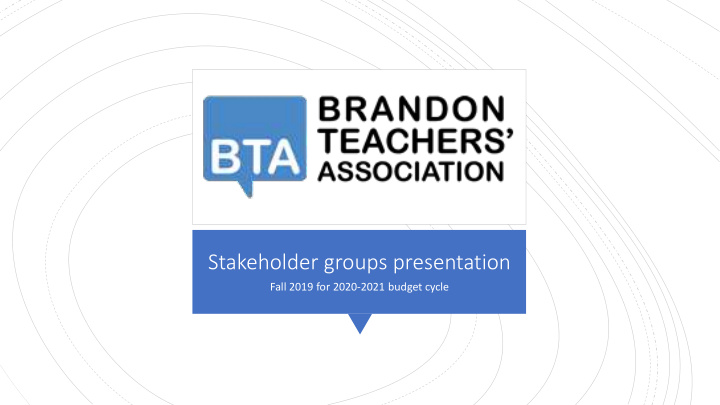



Stakeholder groups presentation Fall 2019 for 2020-2021 budget cycle
Questions Regarding the Process from BTA Education Finance Committee
BUDGET CYCLE: With the stakeholders meetings in October and also budget requests due from Trustees simultaneously, we do not feel that trustees have adequate time to consider stakeholders’ requests. • We know we all want what’s best for students, but we are concerned that this budget cycle creates difficulty. • Could requests or suggestions we make today be realistically taken on by trustees, researched and reviewed, approved and moved forward to committee in time for budget approval? • What would the time frame be for a Trustee to research and review a suggestion we make today? • May we suggest that stakeholders be consulted with earlier in the cycle?
STAKEHOLDERS MEETINGS • Trustee requests have to come from individuals in October and then brought to committees for approval in November. • Why is the whole board not present to hear stakeholders suggestions, since all Trustees can bring forward a request and the various requests may fall under the purview of several different board committees?
Areas of Concern and Additions from Members
Survey says. . . The Education Finance committee surveyed members regarding additions they would like to see in the budget. BTA council members were also asked round-table discussion questions. • Class size was the outstanding issue mentioned by members • In the 2017-2018 Continuous improvement Report (page 24), grades 3-4 students show improvement in both literacy and numeracy results. Those students would have experienced the 20K3 class size cap. What impact has the K3 class size cap had on these results? Is there value in maintaining it? Currently, schools such as Riverheights and Waverly have upwards of 26 and 27 students in some of these grade levels. • The number three issue was the substitute shortage. • The other outstanding issues for our members were: class composition, clinicians, tier 2 support in numeracy and literacy, EAL support, guidance, and resource.
How are staffing and service levels determined? By the budget! • Our members are focused on this issue because. . . • Betty Gibson school has one of the most diverse and at-risk student populations in the division, and over the last three years, they have lost 0.5 FTE Reading Recovery, 1.0 FTE EAL, 0.5 Counsellor as well as some teacher librarian time. • Earl Oxford has a similar student demographic, and they lost a 1.0 FTE in staffing. They lost 0.5 FTE reading recovery, 0.25 FTE numeracy support and 0.25 FTE resource. • We are aware that particular staffing configurations are decided by the Superintendent as stated in section 52 of the PSA. However, the Superintendent sets staffing based on the budget. • We would ask that all positions that support our vulnerable students be restored.
Increases to the operational budget • The board has always attempted to limit special levy increases to the sum of inflationary pressures plus enrollment growth. • Working to the recommended 2% cap on Special Levy growth set by the Provincial government would have the board add about $800 000 to the budget this year. • Working to the guideline set by the board be 1.5% + 2.18% for enrollment growth. This would mean adding approximately $1 465 000.
Additions: A Summary • The number one concern of teachers was to bring down class sizes, and that includes both student-teacher ratio and student-educator ratio. • We also would like to emphasize that division-wide averages can hide the realities at some of our sites. For example, Riverheights gained 75 students and only 1 teacher last year. • Members want positions that were reallocated last year, notably at our highest-needs buildings, to be restored. • Members want support positions including EAL coordinator, EAL teachers, counsellors, EAs and Tier 2-3 support personnel to be enhanced.
Other Questions: 1 1. There is now $2.8 million from the 2018-2019 budget that will not be allocated to capital reserves after the decision by the PSFB to not approve these capital reserve requests. This means that the accumulated surplus still sits at 6.7% of operating fund expenses. • This exceeds the policy cap set by the province. 2. What will happen with this 6.7% accumulated surplus from the 2018-2019 budget? How much money does this represent? How many FTEs does this represent? 3. How will the capital projects be funded?
Other Questions: 2 • During last year’s budget discussions, bussing to middle years programming was not approved because it was considered pre- mature in light of the addition of middle years options. However, an industrial arts teaching position was lost before the new program commenced. We now have 2 industrial arts teachers, rather than 3. Members have told us that the typical industrial arts teacher had approximately 210 students prior to the program changes. • Has Industrial arts registration decreased by 200 or more students? • How many students are currently registered in industrial arts?
Recommend
More recommend